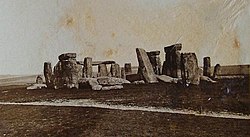John Aubrey
Aubrey was born at Easton Piers or Percy, near Kington St Michael, Wiltshire, to a long-established and affluent gentry family with roots in the Welsh Marches.
In 1649, Aubrey discovered the megalithic remains at Avebury, which he later mapped and discussed in his important antiquarian work Monumenta Britannica.
Aubrey said his memory was "not tenacious" by 17th-century standards but from the early 1640s he kept thorough (if haphazard) notes of observations in natural philosophy, his friends' ideas, and antiquities.
His erstwhile friend and fellow-antiquary Anthony Wood predicted that he would one day break his neck while running downstairs in haste to interview some retreating guest or other.
Aubrey was an apolitical Royalist, who enjoyed the innovations characteristic of the Interregnum period while deploring the rupture in traditions and the destruction of ancient buildings brought about by civil war and religious change.
He drank the King's health in Interregnum Herefordshire, but with equal enthusiasm attended meetings in London of the republican Rota Club.
From this time he was dependent on the hospitality of his numerous friends; in particular, Sir James Long, 2nd Baronet, and his wife Lady Dorothy of Draycot House, Wiltshire.
Aubrey died of an apoplexy while travelling, in June 1697, aged 71, and was buried in the churchyard of St Mary Magdalen, Oxford.
As a hanger-on in great houses, he had little time and little inclination for systematic work, and he wrote the "Lives" in the early morning while his hosts were sleeping off the effects of the night before.
Aubrey himself valued the evidence of his own eyes above all, and he took great pains to ensure that, where possible, he noted not only the final resting places of people, but also of their portraits and papers.
He presented them to Anthony Wood in 1681 but continued to work on them until 1693, when he deposited his manuscripts (in three folio volumes) in the Ashmolean Museum: they are now in the Bodleian Library, as MSS Aubrey 6–8.
A near-complete transcript, Brief Lives, Chiefly of Contemporaries, Set Down by John Aubrey, Between the Years 1669 and 1696, was edited for the Clarendon Press in 1898 by the Rev.
This remained the standard edition for scholarly use for many years, but (from a modern perspective) was flawed by the number of excisions Clark had made in the interests of "decency".
For instance, Aubrey wrote of John Milton: "His complexion exceeding faire—he was so faire that they called him the Lady of Christ's College."
He wrote of William Butler: "The Dr. lying at the Savoy in London, next the water side where was a balcony look't into the Thames, a patient came to him that was grievously tormented with an ague.
Of William Shakespeare: "His comedies will remain wit as long as the English tongue is understood, for that he handles mores hominum [the ways of mankind].
Independently, in 1659, a self-appointed committee of Wiltshire gentry determined that a county history should be produced on the model of William Dugdale's Antiquities of Warwickshire.
The work on the antiquities (which he entitled Hypomnemata Antiquaria) was closely modelled on Dugdale, and was largely finished by 1671: Aubrey deposited his draft in the Ashmolean Museum in two manuscript volumes.
In 1685 Aubrey recast the work, now modelling it on Robert Plot's Natural History of Oxford-shire (published in 1677); and it was effectively finished by 1690–91, when he transcribed a fair copy.
In 1673, the royal cosmographer and cartographer John Ogilby, planning a national atlas and chorography of Britain, licensed Aubrey to undertake a survey of Surrey.
In a much-revised form (with both additions and excisions) it was published by Richard Rawlinson as the Natural History and Antiquities of Surrey in five volumes in 1718–19.
[14] The Remaines of Gentilisme and Judaisme was Aubrey's collection of material on customs, traditions, ceremonies, beliefs, old wives' tales and rhymes—or what today would be termed folklore.
The manuscript came into the hands of White Kennett, and as a result it is not with Aubrey's other collections in the Bodleian: it is in the British Library, as Lansdowne MS 231.
[15] Aubrey's Interpretation of Villare Anglicanum (its preface dated 31 October 1687) was the first attempt to devote a work entirely to the subject of English place-names.
[16] Aubrey compiled a list of some 5,000 place-names, but managed to provide derivations for only a relatively small proportion of them: many are correct, but some are wildly wrong.
The only work published by Aubrey in his lifetime was his Miscellanies (1696; reprinted with additions in 1721), a collection of 21 short chapters on the theme of "hermetick philosophy" (i.e. supernatural phenomena and the occult), including "Omens", "Prophesies", "Transportation in the Air", "Converse with Angels and Spirits", "Second-Sighted Persons", etc.
In 1967, English director Patrick Garland created a one-man show, Brief Lives, based on Dick's edition of Aubrey's work.
Aubrey scholars, however, have sometimes seen the production as over-emphasising its subject's eccentricities and lack of organisation, to the detriment of a wider appreciation of his contributions to scholarship.

